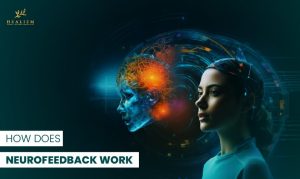
The brain is a complicated and exciting organ that can learn and adapt uniquely.
Neurofeedback is an innovative method that uses the brain’s ability to change.
But what is neurofeedback, and how does it work?
Healizm is a better place to get help for mental health problems.
You can contact us for your curies about mental health.
We will discuss the basics of neurofeedback, how it can be used, and how it can help improve mental health and brain function in different ways.
What is Neurofeedback?
Neurofeedback, or electroencephalography (EEG) biofeedback, is a non-invasive therapy that teaches the brain to manage its own activity.
That idea comes from neuroplasticity, which says that the brain can change how it works by connecting new nerve cells.
According to NCBI neurofeedback gives people real-time feedback on their brainwave patterns, which helps them change how their brains work.
This makes them smarter and more in control of their emotions.
You can read a complete beginner’s guide here.
Benefits of Neurofeedback Therapy
The best thing about neurofeedback therapy is that it can show how the brain works on the inside. Provider can see how you react to things you were not even aware of.
This can help you figure out what behaviors are not helpful and work to change them.
Neurofeedback therapy is also helpful because it lets you see how your brain is working right now.
This helps you understand your reactions better and see them from a different point of view.
This is especially helpful for people who have trouble controlling their anger because they are often easily upset by outside opinions.
How Does Neurofeedback Work?
-
First Neurofeedback Session
During the first evaluation, an electroencephalogram (EEG) is used to record the client’s brainwave activity.
Putting small sensors on the head to pick up electrical activity in the brain is part of this process.
The baseline test helps find parts of the brain that might be overactive or underactive, giving the training a place to begin.
-
Setting Goals
The assessment is used to set clear goals for the neurofeedback sessions.
Some of these goals could be to lower anxiety, sharpen focus, improve the quality of sleep, or deal with the effects of conditions like depression or ADHD.
-
Neurofeedback Therapy Training
The person getting neurofeedback wears EEG sensors that record real-time information about their brainwave activity.
This activity in the brain is then turned into feedback that you can see or hear, like a moving graph, a video game, or sounds.
For example, if the brain makes the patterns that are wanted, the feedback could be a sound or a video that plays smoothly.
If the brain’s activity does not follow these patterns, the feedback changes to let the person know they need to make changes.
This helps the person learn to regulate their brain activity for better mental performance and emotional control.
-
Learning and Adaptation
Repeated sessions teach the brain to associate specific brainwave patterns with positive feedback.
This operant conditioning method helps the brain stay in the desired state, which changes how the brain works in a way that lasts.
Over time, people may feel better about their symptoms and their overall mental and emotional health.
Neurofeedback Can Be Used For
Neurofeedback is a method that has been used to treat a wide range of neurological and mental health problems, such as
- Anxiety and Stress: Neurofeedback can help with anxiety and stress by making you feel calmer and lowering brainwave patterns that are too active.
- Attention Deficit Hyperactivity Disorder (ADHD): Neurofeedback can help people with ADHD focus better and be less impulsive by teaching the brain to make brainwave activity that is more balanced and regulated.
- Depression: Neurofeedback can be used along with other treatments for depression because it targets brainwave patterns that are linked to controlling mood.
- Sleep Disorders: EEG Neurofeedback for sleep disorders it can help people who have trouble sleeping by promoting the brainwave patterns that are linked to deep sleep.
- Peak Performance: Neurofeedback is used by athletes, musicians, and business leaders to improve brain function, focus, and mental clarity.
In conclusion, how does neurofeedback work?
Neurofeedback is an effective and painless treatment that uses the brain’s natural ability to adjust and change.
Giving people real-time feedback on their brain activity can help them improve their overall brain health, mental performance, and ability to control their emotions.
Neurofeedback is a promising way to improve health, whether you are dealing with anxiety, ADHD, sleep problems, or want to perform at your best. Get in touch with Healizm for personalized help and learn more about how neurofeedback can help you.
FAQs
-
How does neurofeedback work?
- When someone gets neurofeedback, sensors are put on their head to record EEG signals, which show how their brain is working electrically. After that, the brain waves are analyzed and shown on a screen so that both the therapist and the patient can see what is happening in the brain at the same time.
- The neurofeedback system finds patterns in brain activity and gives immediate feedback, which is usually in the form of sound or light. This feedback helps the brain understand and change how it works.
-
What happens during a neurofeedback session?
Sensors are put on the patient’s head while they are sitting comfortably to measure their neurological activity. The therapist runs the session and gives the brain feedback through sounds or pictures.
The patient does not have to do anything during the session because the brain responds to the feedback on its own and learns how to control itself.
-
Can neurofeedback help with specific conditions?
Neurofeedback has helped people with PTSD, learning disabilities, ADHD, anxiety, depression, and a lot of other issues. However, it is not a cure or treatment for these conditions. Instead, it is a learning tool that can help the brain work better.
